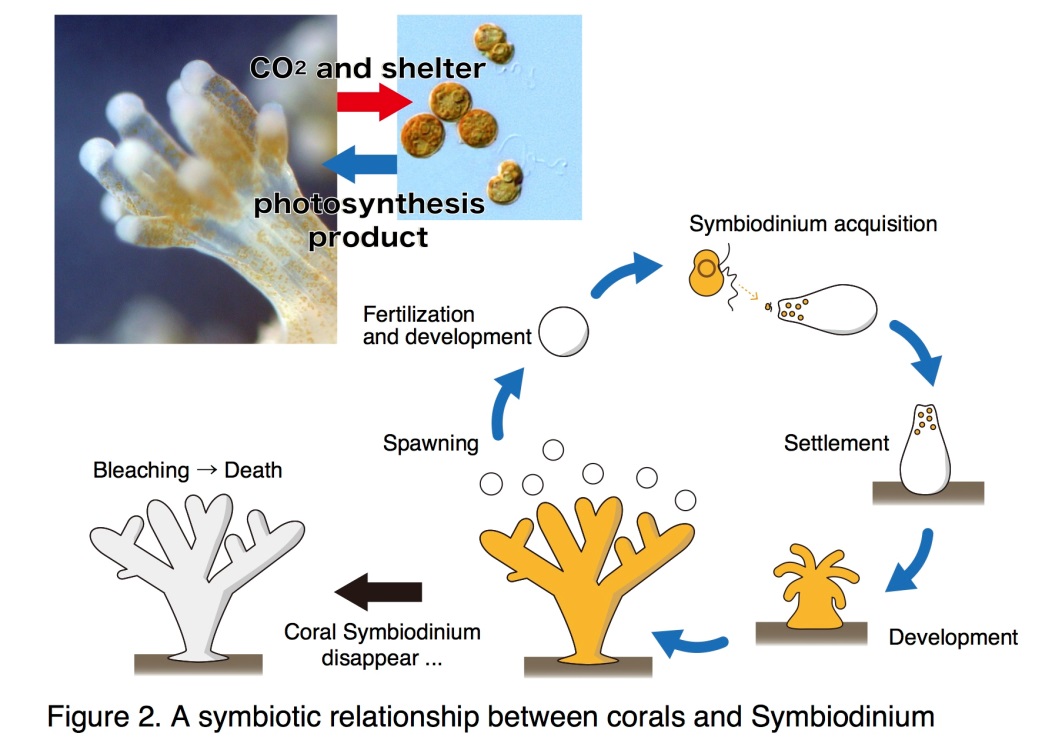Interactions
The main kind of interaction that Cassiopea xamachana exhibits is a symbiotic relationship with photosynthetic dinoflagellates (Todd et al. 2006, Thornhill et al. 2006, and McGill et al. 2008). Dinoflagellates fall under the genus Symbiodinium along with zooxanthellae; this is another species of symbionts Cassiopea interact with regularly (Thornhill et al. 2006). A symbiont is one of two organisms in a symbiotic relationship. In this case it is a mutualistic relationship; both organisms are benefitting from the interaction. Which kind of Symbiodinium the Cassiopea host relies largely on the environment (Thornhill et al. 2006). Cnidarians as a phylum are known to host populations of dinoflagellates that are genetically similar, but are able to work with all four clades of dinoflagellates in the Symbiodinium genus (Thornhill et al. 2006). Cassiopea are also able to have mutualism with more than one kind of symbiont (Thornhill et al. 2006).
Environmental changes will impact which symbiont Cassiopea will host (Thornhill et al. 2006). When the environment changes Cassiopea may switch symbiont species (Thornhill et al. 2006). This is done by partner recombination (Thornhill et al. 2006). This is because different species of Symbiodiniums help Cassiopea to adapt to changes or stressors in their environment (McGIll et al. 2008). The organism that Cassiopea has a symbiotic relationship with can often depend on the type of reproduction Cassiopea displays (Thornhill et al. 2006). In the case of broadcasting spawn, “horizontal” acquisition is used to obtain symbiosis. This means that the symbiont joins Cassiopea via direct contact (Thornhill et al. 2006). Broadcasting spawn are expelled into the surrounding waters and attract a more varied selection of symbionts (Thornhill et al. 2006). The broadcasting spawn may select many Symbiodiniums at first, but will eventually specify (Thornhill et al. 2006). Brooding larvae use “vertical” transmission to achieve symbiosis. Vertical transmission is where the symbiont gives birth to more of its kind while already harboring on the host (Thornhill et al. 2006). In both cases, chemical cues provide the necessary symbiont-host relationship (Thornhill et al. 2006).
Cassiopea xamachana takes in nutrients to suit the requirements of its symbiotic partners. In return, dinoflagellates carry out photosynthesis to fuel the needs of Cassiopea (Todd, et al. 2006). This symbiont-host relationship is similar to the one that corals may have with their symbiotic partners (McGill et al. 2008). Occasionally the partners will live apart, which is called aposymbiotic. When this occurs, dinoflagellates and Cassiopea are negatively affected (Thornhill et al. 2006). Lack of a symbiont causes the jellyfish to lack in biological function and survival. This is why bleaching poses such a threat to Cassiopea; they become unable to support Symbiodinium’s photosynthesis (McGill et al. 180). Carrying out photosynthesis allows t Symbiodiniums to provide Cassiopea with alanine, glycerol, and glucose (McGill et al. 2008). They also aid in Cassiopea’s growth, development, and metabolic activities (McGill et al. 2008). While there are some outside means for Cassiopea to gain nutrients, they are limited. The jellyfish can do the bare minimum for metabolism and nutrient acquisition, but it is unknown how well or for how long they can live without a symbiotic connection (McGIll et al. 2008).

